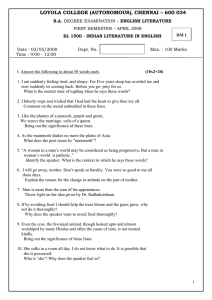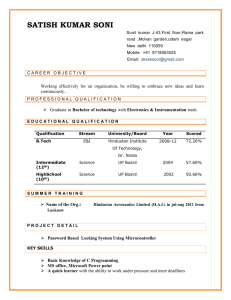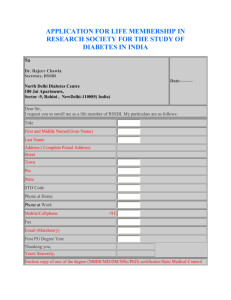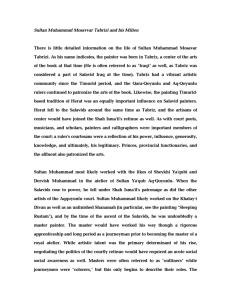CHAPTER-1 THE MEDIEVAL WORLD
advertisement
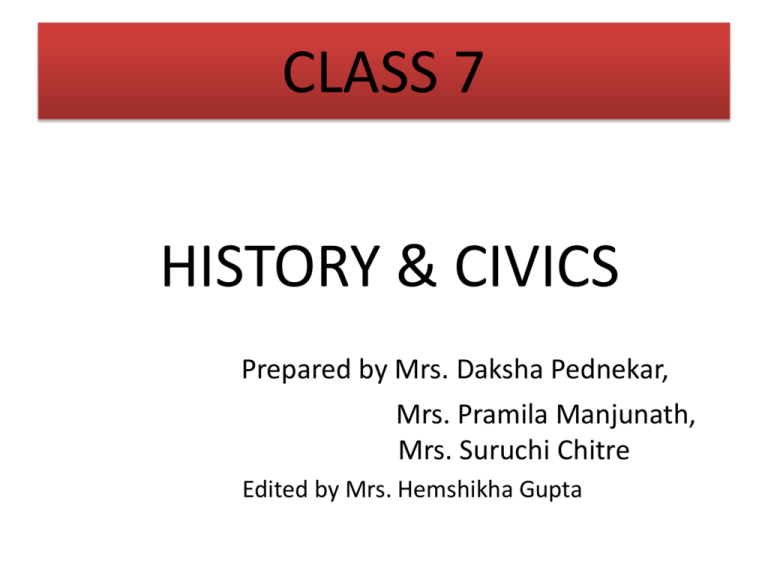
CLASS 7 HISTORY & CIVICS Prepared by Mrs. Daksha Pednekar, Mrs. Pramila Manjunath, Mrs. Suruchi Chitre Edited by Mrs. Hemshikha Gupta HISTORY DIVIDED INTO THREE PERIODS Ancient Medieval or Middle Modern CAUSES THE BIRTH OF JESUS EFFECTS Romans conquered Palestine Around 6-4 BCE, Jesus, son of God was born to Mary in Bethlehem in Judea. Jesus' interpretation of Jewish laws clashed with the ideas of Jewish religious leaders. Appointed Herod, A puppet ruler - the Jews suffered under him. Jesus grew up in They felt threatened by Nazareth, in Palestine, his growing popularity. where he studied Jewish scriptures. Jews looked forward with hope and faith, the coming of a ‘Messiah’ His baptism took place Jesus was put on trial when he was 30 years and sentenced to death. old. He is believed to have resurrected. Church became conservative and authoritarian Germanic tribes left Roman church unharmed By 900 CE, most Europeans converted to Christianity SPREAD OF CHRISTIANITY Monasteries built and they became centers of learning and religion Christian monks organized themselves into religious orders The power and wealth of church multiplied CRUSADERS THEIR EFFECTS 11th century CE-Turks invaded Constantinople. Paved the way for the ‘Renaissance’. Pope appealed all Christians to join the Crusades (the holy wars) against the Turks to recover Jerusalem. Contributed to the decline of ‘Feudalism’. Between 11th and 13th Re-established direct trade contacts centuries CE, the Christians led between Europe and other parts of the 8 military expeditions against world. Turks. Brought several changes in medieval Europe. Many new towns and cities were established. MONASTERIES Active members of the Monasteries Features of the Monasteries Role of the Monasteries 3. ISLAM AND ITS IMPACT ON MIDDLE EAST THE ADVENT OF ISLAM - LIFE OF PROPHET MUHAMMAD Prophet Muhammad - born in Mecca in 570 CE - Founder of Islam Came in contact with Christian and Jewish religious beliefs and practices Spent lot of time in prayer and meditation Around 610 CE, God spoke to him and revealed to him the divine message Declared that Allah was the only God and Muhammad was His Prophet. New religion - Islam, followers of Islam - Muslims SPREAD OF ISLAM PROPHET MUHAMMAD PRINCIPLES 1. There is only one God and Muhammad is His Prophet. 2. Muslims must say their prayers five times a day. 3. They must help he poor and needy by giving away a portion of their wealth in charity. ABU BAKR 1. Abu Bakr was Muhammad’s faithful friend and follower and was selected as his successor. 2. He took the title of Khalifa or Caliph. 3. He mobilized and transformed the Arabs into an excellent fighting force. MEDIEVAL PERIOD IN INDIA MEDIEVAL PERIOD IN INDIA (8TH TO 18TH CENTURY CE Early Medieval (8th-13th Century CE) Delhi Sultanate (1200-1526 CE) Mughal Period (1526-mid-18th century CE) Later Medieval (13th - 18th Century CE) MAHMUD OF GHAZNI Invaded India 17 times from 1001-25 CE and plundered its riches He attacked the Somnath Temple in Kathiawar, which was his most ambitious and profitable expedition. The Persian poet, Firdausi, author of the great epic, Shahnama, and the great Persian historian and mathematician, AlBeruni, were among the eminent scholars patronized by Mahmud. MUHAMMAD GHORI • He was the founder of the Turkish kingdom in India. • A new chapter in Indian history had begun. IMPORTANT BATTLES • First battle of Tarain – 1191 CE – Prithviraj Chauhan inflicted a crushing defeat on Ghori. • Second Battle of Tarain – 1192 CE – Ghori routed the Rajput army. DELHI SULTANATE 1206-1526 CE QUTBUDDIN AIBAK • He founded the Mamluk Dynasty and ruled between 1206-10 CE • He was a just and generous ruler and was known as ‘lakhbaksh’. • The great monument Qutb Minar was started by him. ILTUTMISH • He (120-36 CE was the true founder of the Turkish rule in India. He was a capable ruler. • He consolidated his possessions and stabilized his position by shrewd and clever handling of all those challenged his authority. RAZIA SULTAN • She (1236 – 39 CE) was the first great woman monarch. • She sat in the open durbar and transacted business. • The welfare of her subjects was her primary duty. GHIYASUDDIN BALBAN • He (1266-86 CE) was an experienced and capable ruler. • He believed in the theory of ‘divine kingship’, i.e. the king was God’s representative on earth. • The peaceful and stable conditions during his reign were favourable for the development of agriculture, trade and commerce and led to the economic prosperity. Jalaluddin Khilji was the founder of the Khilji dynasty ALAUDDIN KHILJI • He (1296-1316 CE) declared himself the Sultan and ascended the throne of Delhi. • He was a brilliant general and a shrewd administrator. • He dreamt of conquering the whole world. • He was the first Turkish Sultan to build an empire in India. ALAUDDIN KHILJI REORGANIZAT ION OF ARMY • First to lay the foundation of standing army. • Introduced the system of ‘dagh’ and ‘chehre’ REVENUE REFORMS • The land was measured and the share of the state was fixed. • The Sultan increased the revenue from one third to half. It was to be paid in cash. MARKET CONTROL POLICY • Price control was introduced. • The prices of all commodities were fixed and prices of essential commodities were kept low. • Anyone caught hoarding goods or cheating customers in price or weight was severely punished. ART AND ARCHITECTURE • Alauddin was a patron of art and learning. • Amir Khusrau, the famous Persian poet, lived in his court. • The Alai Darwaza is the most beautiful specimen THE TUGHLAQ DYNASTY GHIYASUDDIN TUGHLAQ • He was the founder of the Tughlaq Dynasty. • He was an efficient administrator and a capable military command. • He introduced several reforms for the welfare of his subjects. • He restored peace and stability in the Delhi Sultanate. MUHAMMAD BIN TUGHLAQ • He (1324-51 CE) was the most learned and accomplished scholar. • He was gifted with an extraordinary memory and a keen intellect. • He had mastered logic, philosophy, mathematics, astronomy and physical sciences. • He was a diligent ruler and undertook many projects as follows. MUHAMMAD BIN TUGHLAQ’S PROJECTS TAXATION IN DOAB • To increase military resources he needed additional revenue. • The tax in the GangaYamuna Doab was increased TRANSFER OF CAPITAL • He shifted his capital from Delhi to Devagiri (renamed as Daulatabad) TOKEN CURRENCY • Copper coins, having the same vaue as gold and silver coins, were issued and people were ordered to use these token coins in all their transactions. EXPANSION SCHEMES • He dreamt of establishing a world empire. • He decided to conquer Khurasa, Persia and Iraq. • A hige arm was mobilized, well eqipped and paid one full year’s salary in advance. FIROZE SHAH TUGHLAQ • He (1351-88 CE) was a peaceloving, just and benevolent ruler. • The welfare of his subjects was his primary concern. • He introduced numerous welfare schemes to improve the economic condition of his subjects and promote material prosperity. FIROZE SHAH TUGHLAQ ECONOMIC REFORMS PUBLIC UTILITY MEASURES JUDICIAL REFORMS PATRON OF ART AND ARCHITECTURE INVASION OF TIMUR INVASION OF TIMUR THE SAYYID AND THE LODI DYNASTIES • The final blow to the Sultanate was dealt by Amir Timur, the Mongol ruler of Samarkand in Central Asia. • Taking advantage of the weak Tughlaq rule, Timur invaded India in 1398-99 CE to plunder its wealth. • Khizr Khan overthrew the last Tughlaq Sultan and established the rule of the Sayyid dynasty in 1414 CE. • The Sayyids ruled Delhi for 38 years. • An Afghan dynasty called he Lodis (14511526 CE) was founded by Bahlul Lodi • Babur invaded India in 1526 CE and killed Ibrahim Lodi in the First Battle of Panipat, which was turning point in the history of India. SOCIAL AND CULTURAL LIFE SOCIETY ARISTOCRACY Consisted of the Sultan, the nobles, the Hindu rajas and princes and the landlords. PRIESTS Consisted of the ulema, maulvis, qazis and brahmanas. TOWN DWELLERS Consisted of officials, artisans, craftspeople, merchants, slaves and domestic servants. PEASANTS The life of the peasants was one of hard work, drudgery and poverty. LIFE UNDER THE DELHI SULTANATE (CONT.) ART AND ARCHITECTURE * Indo-Islamic style was introduced. * Characteristic feature – extensive use of bricks, arches, domes, beams and balconies MUSIC AND DANCE * Hindustani music was the outcome of the fusion of the Perso-Arabic and Indian classical music styles. *Invention of sitar by Amir Khusrau *Qawwali and Kathak dance forms. PAINTING *The Rajput style of miniature painting continued on this period. OTHER CULTURAL CHANGES *Clothing – pyjama-kurtas, kaftans, salwarkameez. *Food – biryani, bread, wine. *Turkish rulers assimilated many Hindu cultural triats. Administration CAPITAL CITY ECONOMIC CONDITION • Developed around Hampi. •Streets were paved and well laid KRISHNADEVARAYA •Imposed custom duties •Promoted agriculture •Precious Stones openly sold in bazars RELIGIOUS TOLERANCE • No Caste discrimination Allaudin Hassan-Established-Under the title Allaudin Bahman Shah Bahmani kingdom reached the height –Mahmud Gawan scholarship to poor and deserving students. Led a spartan lifestyle. A capable administrator. Bahmani kings –great builders. Chand Minar, forts of Faizabad, Gol Gumbaz, tomb of Adil Shah BABUR–The Founder of the Mughal Empire The First Battle of Panipat Defeat of Sultan of Delhi Battle of Khanwa Supreme Control over Central India Battle of Chanderi and Battle of Ghagra Babur’s memoir Tuzk-I-Baburi OR Baburnama HUMAYUN Empire divided between himself and three brother's. Military Expedition Chunar, Gujarat , Malwa,Bengal Battles fought with Sher Khan Battle of Chausa , Battle of Kanauj Humayun’s Exile Humayun Returns Founder of Afghan Rule Central and Provincial Administration. Empire divided into 47 Provinces or Sarkars. Military Organization Dagh –branding Horses. Chehra descriptive roll of soldiers were Revived. Communication System & Grand Trunk Road Sarais –rest house and Dak Chaukis were built. Trade and Commerce Silver coin issued-Rupia Religious Policy Literature and architecture Rohtasgarh, Own tomb Malwa, Gondwana, North West ,Deccan CONQUEST Subjugation of Rajputs Conflict with Maharana Pratap AKBAR Wazir, diwan, qazi, Diwan-i-Khas, Diwan-i-Aam ADMINISTRATION The Mansabdari system Revenue system,Todar Mal Bandobast One nation, equal status Ibadat Khana Akbar’s Religious Policy Akbar’s Religion (Sulh-i-kul) Din-i- Ilahi Rajput policy Social and Cultural Achievements Social Reforms, Educational Reform Literature, Paintings Architecture, Music Nine Gems Rebellion of Khusrao Arrival of East India Company SALIM-Ascended the throne under title of JAHANGIR Nur Jahan Conquest Mewar, Deccan, Kangra DECCAN CAMPAIGN CENTRAL ASIA CULTURAL ACHIEVEMENTS BUILT MAGNIFICENT BUILDINGS MAIN EVENTS EXPULSION OF PORTUGESE THE REIGN OF AURANGZEB AND THE MARATHAS North-East, North-West Frontier East India and The Jats Vast empire and administration led to revolts The Satnamis The Bundelas The Sikh The Rajputs Defeat of Afzal Khan and Shaista Khan Treaty of Purandhar Shivaji’s Coronation Administration- Revenue-Swarjya Mughlai,Chauth,Sardeshmukhi Political System- Asthapradhan Military System- Guerilla warfare RELIGIOUS MOVEMENTS Moinuddin Chisti-Founder SUFI MOVEMENT Teachings of Sufism Only one god Monastic organizationSilsilas,Chisti, Suhrawardi popular in India. BHAKTI MOVEMENT Teachings of Bhakti Saints Everyone should lead a pure life. Impact of Religious Movements Exposed the futility of rites and rituals. Spirit of Enquiry Humanism FEATURES Scientific Spirit Rationalism Science Literature Art and Architecture Geographical Discoveries IMPACT CLASS 7 CIVICS Chapter 17: THE MAKING OF OUR CONSTITUTION THE CONSTITUTION • The Preamble- an introduction to constitution • Source of the ConstitutionWee the people of India NATURE OF THE STATE • • • • • Sovereign Socialist Secular Democratic Republic OBJECTIVE OF THE CONSTITUTION • • • • Justice Liberty Equality Fraternity Chapter 18: FUNDAMENTAL RIGHTS AND DUTIES Fundamental Rights Fundamental Duties • • • • • • Right to Equality Right to Freedom Right to Freedom of Religion Right against Exploitation Cultural and Educational Rights Right to Education • Respect the Constitution, National Flag and the National Anthem • Protection of Sovereignty, Unity, brotherhood and Integrity • Preservation of Cultural Heritage and National Environment Chapter 19: DIRECTIVE PRINCIPLES OF STATE POLICY • Equal distribution wealth • Utilization of resources for all • Adequate means of livelihood • Equal pay for both men and women • The right to work • Assistance for the old, sick disabled and the unemployed • The right to free and compulsory education • Welfare schemes for the Scheduled Castes and Scheduled tribes • Equal pay for both men and women • Free and compulsory education • Promotion of cottage industries • Improvement of general health of the people • Establishment of village panchayat PRINCIPLES PROMOTING ECONOMIC EQUALITY IMPLEMENTATI ON OF DIRECTIVE PRINCIPLES GHANDIAN PRINCIPLES GENERAL PRINCIPLES • Promotion of international peace and security • Just and honorable relations with other countries • Safeguard forests and wildlife • Protect objects, places and monuments of national importance Chapter 20: THE UNION AND STATE LEGISLATURE PARLIAMENTARY FORM OF GOVERNMENT THE UNION LEGISLATURE FUNCTION OF THE PARLIAMENT • Functions of the government • The three list of subjects of Legislation – The Union List, The State List and the Concurrent List • THE LOK SABHA-Composition, Qualification, voting by secret Ballot, Universal Adult Franchise, Term and the Speaker THE RAJYA SABHA-Composition, Qualification and the chairperson • Law making functions • The Budget • Control over the Executives • Judicial Functions • Elective Functions THE STATE LEGISLATURE THE VIDHAN SABHA • COMPOSITION • TERM • QUALIFICATION THE VIDHAN PARISHAD • COMPOSITION • TERM • QUALIFICATION FUNCTIONS OF THE STATE LEGISLATURE • MAKE LAW ON SUBJECTS UNDER THE STATE AND COCURRENT LIST • MAKE BUDGET FOR THE STATE • EXERCISE CONTROL OVER THE CHIEF MINISTER AND COUNCIL OF MINISTERS • CAN PASS VOTE OF NO-CONFIDENCE Chapter 21: THE UNION EXECUTIVE THE PRESIDENT Qualification • Election and termination Powers • Executive • Military • Legislative • Financial • Judicial • Emergency • Discretionary THE VICE PRESIDENT Qualification THE PRIME MINSTER Election • Term • Term • Role of council Function Functions • Chairperson of the Rajya Sabha • Takes over functions of President in his absence • Advice to President • Selection of Council • Distribution of portfolios • Vital link between the President and the Cabinet Chapter 22: THE STATE EXECUTIVE THE GOVERNOR Qualification • Salary and allowances Powers • • • • • Executive Legislative Financial Judicial Discretionary THE CHIEF MINISTER THECOUNCIL OF MINISTERS Qualification • Term • Powers • Election • Term Function Functions • Appoints the Council • Distributes Portfolios to the ministers • Executive decisions taken in the cabinet • Heads of the state departments Chapter 23: THE JUDICIARY The Supreme Court The High Court The Subordinate Courts • Appointment of the judges • Qualification and the term of judges • Composition • Qualification • Term • Meaning • Appointment of the judges Powers Powers • Original Jurisdiction • Appellate Jurisdiction • Advisory Jurisdiction • Original Jurisdiction • Appellate Jurisdiction • Supervises functioning of Subordinate courts Meaning and working of • Panchayat Courts • Lok Adalats
